
Isabel Martínez de Perón is an Argentine politician who served as President of Argentina from 1974 to 1976. She was one of the first female republican heads of state in the world, and the first woman to serve as president of a country.
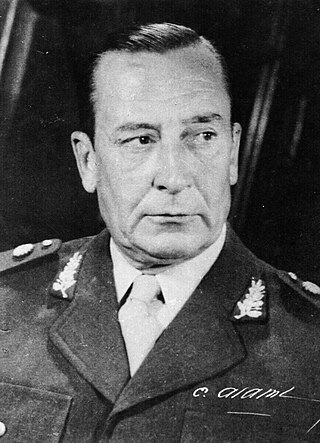
Pedro Eugenio Aramburu Silveti was an Argentine Army general who was the dictator of Argentina from November 13, 1955 to May 1, 1958. He was a major figure behind the Revolución Libertadora, the military coup against Juan Perón in 1955. He was kidnapped by the left-wing organization Montoneros on May 29, 1970 and assassinated as part of retaliation. He had been involved in the June 1956 execution of Army General Juan José Valle—associated with the Peronist movement— and 26 Peronist militants, after a botched attempt to overthrow his regime.

The People's Revolutionary Army was the military branch of the communist Workers' Revolutionary Party in Argentina.
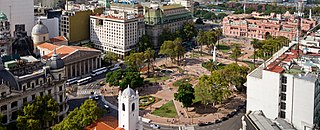
The Plaza de Mayo is a city square and the main foundational site of Buenos Aires, Argentina. It was formed in 1884 after the demolition of the Recova building, unifying the city's Plaza Mayor and Plaza de Armas, by that time known as Plaza de la Victoria and Plaza 25 de Mayo, respectively. The city centre of Buenos Aires, Plaza de Mayo has been the scene of the most momentous events in Argentine history, as well as the largest popular demonstrations in the country. On the occasion of the first anniversary of the May Revolution in 1811, the Pirámide de Mayo was inaugurated in the square's hub, becoming Buenos Aires' first national monument.

The Casa Rosada, literally the Pink House, is the president of the Argentine Republic's official workplace, located in Buenos Aires. The palatial mansion is known officially as Casa de Gobierno. Normally, the president lives at the Quinta de Olivos, the president of Argentina's official residence, located in Olivos, Greater Buenos Aires. The characteristic color of the Casa Rosada is baby pink, and it is considered one of the most emblematic buildings in Buenos Aires. The building also houses a museum, which contains objects relating to former presidents of Argentina. It has been declared a National Historic Monument of Argentina.
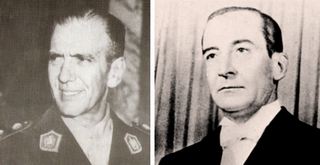
Revolución Libertadora was the coup d'état that ended the second presidential term of Juan Perón in Argentina, on 16 September 1955.

The Bombing of Plaza de Mayo was a massacre that took place in Buenos Aires, Argentina, on 16 June 1955. Thirty aircraft from the Argentine Navy and Air Force strafed Plaza de Mayo in the largest aerial bombing ever on the Argentine mainland. The attack targeted the adjacent Casa Rosada, the official seat of government, while a large crowd gathered to demonstrate support for President Juan Perón. The strike took place during a day of official public demonstrations to condemn the burning of a national flag allegedly carried out by detractors of Perón during the recent Corpus Christi procession. The military reacted as a result of growing tension between President Juan Perón and his actions against the Roman Catholic Church. The action was to be the first step in an eventually aborted coup d'état. The number of identified bodies was put at 308, including six children; an unknown number of victims could not be identified.

The Ministry of Economy of Argentina is the country's state treasury and a ministry of the national executive power that manages economic policy.
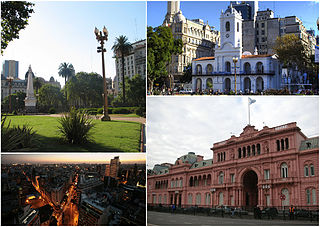
Monserrat or Montserrat is a neighbourhood in the east of the Buenos Aires CBD. The district features some of the most important public buildings in Buenos Aires, including city hall, the city legislature, Casa Rosada, the Colegio Nacional de Buenos Aires and the Libertador Building, among others.
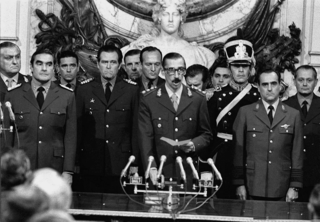
The 1976 Argentine coup d'état that overthrew Isabel Perón as President of Argentina on 24 March 1976, while having some right-wing elements, such as its emphasis on order and security, was not a traditional right-wing coup and did not adhere to a specific ideology. A military junta was installed to replace her; this was headed by Lieutenant General Jorge Rafael Videla, Admiral Emilio Eduardo Massera and Brigadier-General Orlando Ramón Agosti. The political process initiated on 24 March 1976 took the official name of "National Reorganization Process", and the junta, although not with its original members, remained in power until the return to the democratic process on 10 December 1983. The coup was planned and executed within the framework of the Condor Plan, a clandestine system of repressive coordination between Latin American countries promoted by the United States, as part of the national security doctrine, which generalized dictatorships in Latin America in order to maintain the control over those countries during the Cold War.

Argentine Revolution was the name given by its leaders to a military coup d'état which head the government of Argentina in June 1966 and began a period of military dictatorship by a junta from then until 1973.
There are many landmarks in Buenos Aires, Argentina some of which are of considerable historical or artistic interest.

The Argentine legislative elections of 1962 was held on 18 March. Voters chose their legislators and governors; with a turnout of 85.7%.

The Quinta presidencial de Olivos, also known as Quinta de Olivos, is an architectural landmark in the north side Buenos Aires suburb of Olivos and the official residence of the president of Argentina. It is one of the president's official residences.

Juan Manuel Abal Medina is an Argentine journalist and politician who served as Secretary General of the Peronist Movement between 1972 and 1974. He later became a prominent lawyer in Mexico.
The expulsion of Montoneros from Plaza de Mayo was a key event of the third presidency of Juan Perón. It took place on May 1, 1974, during celebrations of International Workers' Day.
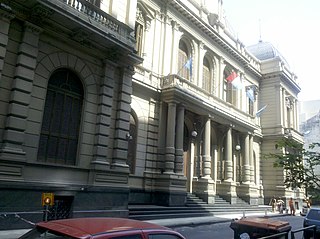
The Headquarters of the Provincial Bank of Córdoba, more often referred locally as Banco de Córdoba Casa Central, is a large bank building in Córdoba, Argentina.

The Ministry of Social Development is a ministry of the Argentine Government tasked with overseeing the country's public policies on issues such as social assistance, welfare and human development across the country. The ministry was created in 1955 as the Ministry of Social Assistance, and it was given its current name in 1999 during the presidency of Fernando de la Rúa. The current minister is Victoria Tolosa Paz, who has served since 2022 in the cabinet of President Alberto Fernández..

The Edificio de la Comandancia en Jefe de la Armada de Chile, also known as Edificio de la Intendencia de Valparaíso, because it was a purpose-built Intendencia, is a building designed in an eclectic style with Renaissance Revival architecture elements, which rises 5 floors in height and covers 8,000 square metres (86,000 sq ft). The main facade of the building faces the Plaza Sotomayor of Valparaíso and the Monument to the Heroes of Iquique.

Unzué Palace, also known as Quinta Unzué, was the presidential residence of the Argentine Republic during the presidency of Juan Domingo Perón (1946-1955), and became a place of pilgrimage and cult after the death of Eva Perón in 1952. The building's symbolic importance was such that, after the military coup that led to Perón's downfall in 1955, the dictators who subsequently took power ordered its complete demolition, in order to erase all traces of its former occupants.






















